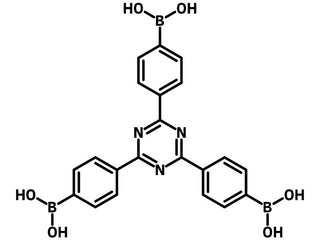((1,3,5-Triazine-2,4,6-triyl)tris(benzene-4,1-diyl))triboronic acid
CAS Number 910231-21-9
Boronates, Chemistry Building Blocks, COF Ligands, Materials, Monomers, Porous Organic FrameworksCovalent Organic Frameworks (COFs) Triazine Ligand
A trigonal boronic acid bridging ligand linker for covalent polymeric frameworks (CPFs) in application of sensors in the field of flexible and wearable electronics, and ciprofloxacin (CFX) detection
Specifications | MSDS | Literature and Reviews
((1,3,5-Triazine-2,4,6-triyl)tris(benzene-4,1-diyl))triboronic acid (TPBATRz), CAS number 910231-21-9, has a structure of triazine (Trz) core with three 4-phenylboronic acid anchoring groups attached at 1,3,5-positions. The boronic acid groups could help to extend the structure via Suzuki coupling reaction to form covalent polymeric frameworks (CPFs). The aromatic dendrimer structures bearing 2,4,6-triphenyl-1,3,5-triazine skeleton as the core features improved thermal stability and photophysical properties associated with improved electron-transfer processes toward the fabrication of OLEDs, OFETs and sensors.
Consisted of a triphenyltriazine core with three peripheral 3-hexylthiophene units, donor–acceptor (D–A) covalent polymeric framework CPF1 exhibited a fast switching time of 5.1 s for colouring and 8.6 s for bleaching with a high coloration efficiency of 163.7 cm2 C−1 and high optical contrast of 36% with a negligible loss of optical contrast over 150 cycles. Sensor based on CPF1 also exhibited high sensitivity, fast response time, and good stability for sensing pressure. The pressure sensor displayed an enhanced sensitivity of ∼2.92 kPa−1 with the durability of ∼2500 cycles.
MOF and COF ligands
Boronic acid ligand for cross-linked COF networks
Worldwide shipping
Quick and reliable shipping
High purity
>98% High purity
Facile reactions
Readily for boronic acid condensation and Suzuki reaction
General Information
| CAS Number | 910231-21-9 |
|---|---|
| Chemical Formula | C21H18B3N3O6 |
| Full Name | ((1,3,5-Triazine-2,4,6-triyl)tris(benzene-4,1-diyl))triboronic acid |
| Molecular Weight | 440.82 g/mol |
| Synonyms | TPBATRZ, TBBA, 2,4,6-tris(4'-dihydroxyborylphenyl)-1,3,5-triazine |
| Classification / Family | Triazines, Boronates, COF ligands |
Chemical Structure

Product Details
| Purity | > 98% |
|---|---|
| Melting Point | N/A |
| Appearance | White to off-white powder/crystals |
MSDS Documentation
 ((1,3,5-Triazine-2,4,6-triyl)tris(benzene-4,1-diyl))triboronic acid MSDS Sheet
((1,3,5-Triazine-2,4,6-triyl)tris(benzene-4,1-diyl))triboronic acid MSDS Sheet
Literature and Reviews
-
Aromatic Dendrimers Bearing 2,4,6-Triphenyl-1,3,5-triazine Cores and Their Photocatalytic Performance, J. Cyniak et al., J. Org. Chem., 86, 6855−6862 (2021); DOI: 10.1021/acs.joc.1c00039.
-
Aggregation-induced electrochemiluminescence and molecularly imprinted polymer based sensor with Fe3O4@Pt nanoparticle amplification for ultrasensitive ciprofloxacin detection, S. Li et al., Microchem. J., 178, 107345 (2022); DOI: 10.1016/j.microc.2022.107345.
-
Vis-to-NIR electrochromism and bright-to-dark electrofluorochromism in a triazine and thiophene-based three-dimensional covalent polymer, S. Halder et al., Mol. Syst. Des. Eng., 7, 1658-1669 (2022); DOI: 10.1039/D2ME00119E.
